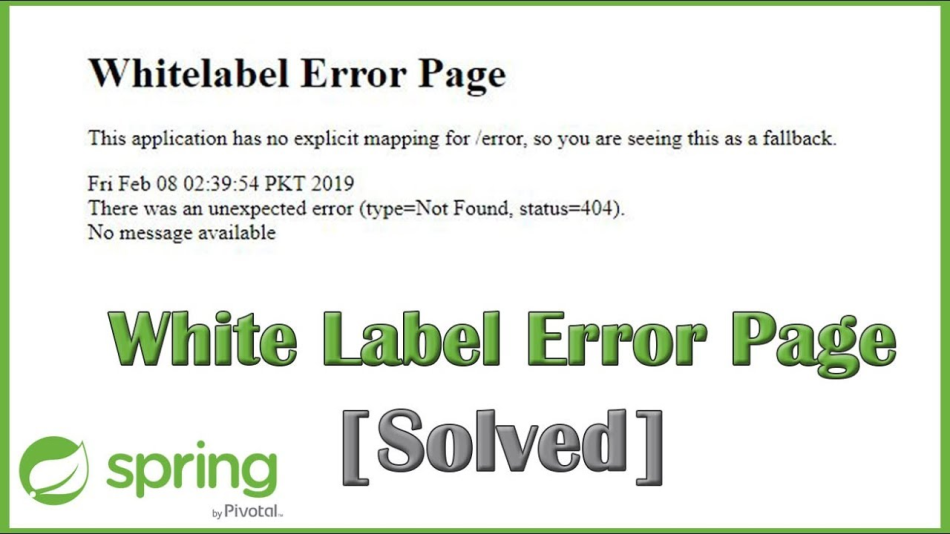Ways to Fix the Whitelabel Error Page When Performing GET Requests in Spring MVC
 Tuanhdotnet
Tuanhdotnet4 min read

1. What Is the Whitelabel Error Page?
The Whitelabel Error Page is a fallback error handler provided by Spring Boot. By default, if an application fails to resolve a request, it serves this error page, typically with a message like:
Whitelabel Error Page
This application has no explicit mapping for /error, so you are seeing this as a fallback.
Sun Nov 12 15:23:48 UTC 2024
There was an unexpected error (type=Not Found, status=404).
Why Does It Occur?
- Missing Controller Methods: The GET request maps to a URL that doesn’t have a corresponding handler in your application.
- Incorrect Configuration: Incorrect application settings, such as mismatched view resolver paths, may trigger the error.
- Dependency Issues: Missing dependencies for handling web requests can result in unresolved endpoints.
2. Steps to Resolve the Whitelabel Error Page
Let’s address the root causes one by one.
2.1 Fix Missing Controller Methods
When you define a route but fail to provide a handler in your controller, Spring MVC cannot process the request. Here’s how to resolve it:
Example
Suppose you attempt to access http://localhost:8080/hello but encounter the Whitelabel Error Page. You may not have a method to handle the request.
@RestController
public class GreetingController {
@GetMapping("/hello")
public String sayHello() {
return "Hello, World!";
}
}
Explanation
- Annotation Usage: @RestController combines @Controller and @ResponseBody, making it perfect for returning data directly from a method.
- Mapping URLs: The @GetMapping("/hello") ensures the /hello endpoint is properly mapped.
With this in place, visiting /hello will return Hello, World! instead of the Whitelabel Error Page.
2.2 Configure a Custom Error Page
To provide a more user-friendly experience, you can create a custom error page for your application.
Example
Define a simple HTML file as your custom error page.
src/main/resources/templates/error.html
<!DOCTYPE html>
<html lang="en">
<head>
<meta charset="UTF-8">
<meta name="viewport" content="width=device-width, initial-scale=1.0">
<title>Error</title>
</head>
<body>
<h1>Something went wrong</h1>
<p>Please contact support if this persists.</p>
</body>
</html>
Explanation
- Default Error Handling: Spring Boot automatically serves error.html when an exception occurs.
- Enhanced UX: Users see a branded error page instead of the generic Whitelabel Error Page.
2.3 Validate Dependencies
Ensure your project includes necessary dependencies to handle web requests.
Example
pom.xml
<dependencies>
<dependency>
<groupId>org.springframework.boot</groupId>
<artifactId>spring-boot-starter-web</artifactId>
</dependency>
</dependencies>
Explanation
- Spring Boot Starter Web: Provides the foundation for web-based applications, including controllers and servlets.
- Error Handling: Missing this dependency often results in runtime errors or an inability to process requests.
2.4 Debugging Common Pitfalls
If the above steps don’t resolve your issue, consider these checks:
- Path Matching: Double-check URL mappings in your controller.
- Port Configuration: Ensure your application runs on the expected port (server.port in application.properties).
- Case Sensitivity: URLs are case-sensitive, so /Hello differs from /hello.
Example
If your GET request fails due to a port mismatch, configure the correct port in application.properties:
server.port=8081
3. Going Beyond: Related Aspects to Consider
Fixing the Whitelabel Error Page is just the beginning. To build robust applications, consider the following:
3.1 Handling Exceptions Gracefully
Implement a global exception handler to manage unexpected errors elegantly.
Example
@ControllerAdvice
public class GlobalExceptionHandler {
@ExceptionHandler(Exception.class)
public ResponseEntity<String> handleException(Exception e) {
return ResponseEntity.status(HttpStatus.INTERNAL_SERVER_ERROR)
.body("An error occurred: " + e.getMessage());
}
}
Explanation
- @ControllerAdvice: Allows centralized error handling across all controllers.
- User Experience: Users see informative error messages rather than the Whitelabel Error Page.
3.2 Logging and Monitoring
To diagnose issues effectively, integrate logging and monitoring tools.
Example
Using Spring Boot Actuator
<dependency>
<groupId>org.springframework.boot</groupId>
<artifactId>spring-boot-starter-actuator</artifactId>
</dependency>
Enable endpoints in application.properties:
management.endpoints.web.exposure.include=*
Explanation
- Visibility: Actuator exposes metrics and health checks, aiding troubleshooting.
- Proactive Error Handling: Identify issues before they escalate.
4. Conclusion
The Whitelabel Error Page in Spring MVC serves as a helpful fallback but can frustrate developers and end-users alike. By addressing the root causes, configuring custom error pages, and implementing robust exception handling, you can transform this obstacle into an opportunity for improvement.
If you have any questions or need clarification, feel free to comment below. Let’s tackle these issues together!
Read more at : Ways to Fix the Whitelabel Error Page When Performing GET Requests in Spring MVC
1
Subscribe to my newsletter
Read articles from Tuanhdotnet directly inside your inbox. Subscribe to the newsletter, and don't miss out.
Written by

Tuanhdotnet
Tuanhdotnet
I am Tuanh.net. As of 2024, I have accumulated 8 years of experience in backend programming. I am delighted to connect and share my knowledge with everyone.